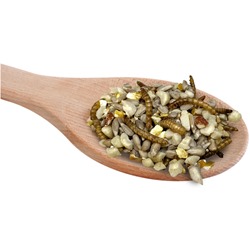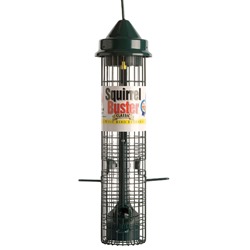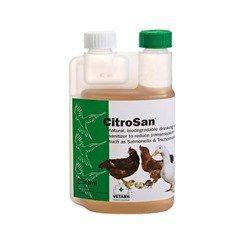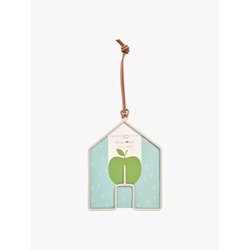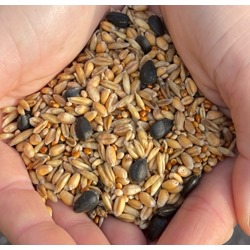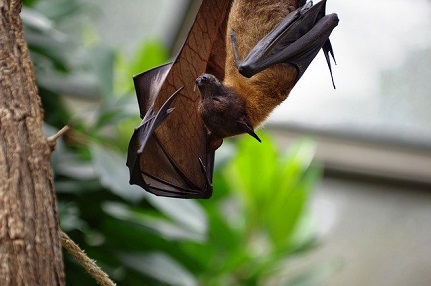
If you've ever been out and about as the sun goes down, we're sure you've seen the bats coming out of their hiding place to hunt. They're found all over the place; in barns, homes and caves, but very few people can get close enough to see the different species that live amongst us.
Well, here in the UK, we don't only have 1 or 2 species of bat living among us, we have 16! So, if you're wondering what species of bat you can see in the UK you're in the right place! Let's take a closer look at some of our favourite flying friends:
Common Pipistrelle Bat (Pipistrellus pipistrellus)
Weighing about as much as a pound coin, the pipistrelle bat is one of the smallest bat species in the UK. They've got black features, brown fur and a wingspan of up to 20cm. As well as being the smallest species, Pipistrelle bats are also the second most common - meaning you've probably already seen one if you've been trying to spot bats in the UK. They like to fly quite close to the ground, so keep your eyes peeled.
- Fun Fact: Despite their size, Pipistrelle Bats can eat up to 3000 insects in one night!
Noctule Bat (Nyctalus noctula)
The Noctule is the largest bat species you'll see here in the UK. Despite their size, they have small round ears make them look quite cute and cuddly! They love to hang out in trees so you'll more than likely spot them if you're near a woodland area. Unlike Pipistrelle bats, Noctule bats love to fly high above the canopy, chirping and calling in a high-pitched tone that only children and young adults can hear.
Daubenton's Bat (Myotis daubentonii)
Daubenton's bats love to come out after dark, so you tend to see them lit up by the moonlight rather than at dusk. They have brown fur, black wings and a pink face. Their predominantly dark bodies makes it easier for them to be camouflaged against the night sky. They favour bodies of water and like to hunt insects on the surface of lakes and ponds.
To catch the insects, the Daubenton's bat swoops down and uses its tail and feet to flick the insects into the air. Once they're hovering above the surface, they can be easily eaten!
The other species of bat that you can see in the UK are; Alcathoe bat, Barbastelle, Bechstein's bat, Brandt's bat, Brown long-eared bat, Greater horseshoe bat, Grey long-eared bat, Leisler's bat, Lesser horseshoe bat, Nathusius' pipistrelle, Natterer's bat, Serotine, Soprano Pipistrelle, Whiskered bat, Greater mouse-eared bat. Phew - that's a lot of bats!
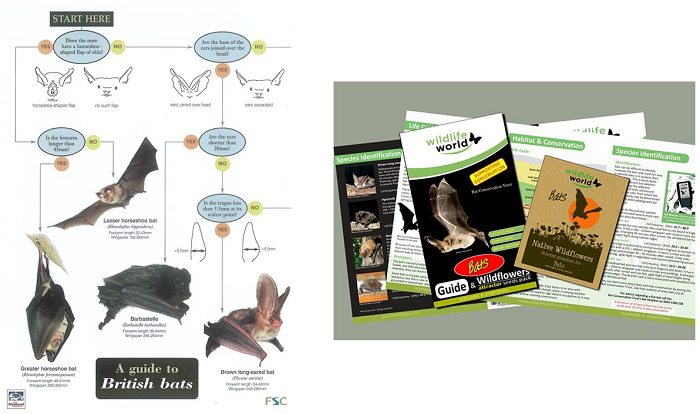
Identifying different species
If you're interested in seeing which bats visit your garden , you might find our Field Guide to British Bats helpful! It's a fold-out chart with all 16 species of bat that you can see here in Britain. It's laminated, meaning you can take it outside even when it's raining!
If you're really keen to increase the number of bats frequenting your garden, you could even consider trying our Bat Attractor Pack. This is a specially curated pack that includes wildflower seeds for night-scented plants, a bat guide, and some more exciting information about the different species.
Shop All Bat Products >
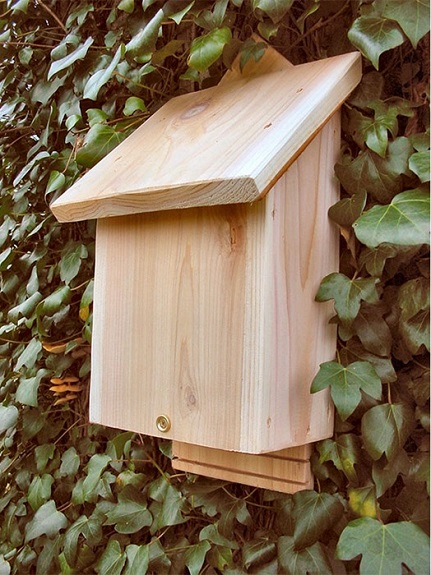
Give the bats a helping hand
We know you only see these guys on a rare occasion, but they're living among us all the time. Much like birds, bats in the UK have to live and adapt to our environment in order to survive. With fewer and fewer natural spaces for them to live and hunt, you'll often find bats in the eaves of buildings where it's dark, narrow and warm. At night, you might see them flitting around your garden looking for food, but don't worry they probably won't get close enough to disturb you!
Bat Boxes
To give the bats a helping hand, you could consider adding a bat box to your house. Giving the bats a quiet, cosy manmade space to rest in your garden will help to:
- Conserve the species
- Give you more opportunities to watch them at night
- Conveniently keep them out of your attic space
We've recently added a wide range of bat boxes and hanging roosts which can provide your local bats with an ideal space to live. Fitted with textured materials, the bats can easily grip the surface inside the box to crawl inside. The bat box you can see in the picture above is the Chavenage Bat Box, made of natural timber and perfect for the Pipistrelle, Noctule or Daubenton's bats!
Browse Bat Boxes >
Bats and the law
As with many species here in the UK, bats are legally protected under the Conservation of Habitats and Species Regulation & the Wildlife and Countryside Act. What does this mean? Well, it means you need to be very careful when it comes to touching, handling or disturbing bats. It's considered a criminal offence if you:
- Deliberately injure or kill a wild bat
- Intentionally disturb a bat in its roost or in a group
- Damage or destroy a place where bats breed or roost
- Possess, sell or advertise any wild species of bat found in the EU (whether it's dead or alive)
- Intentionally obstruct access to a bat roost
What should I do if I find an injured bat?
It's very rare that you'll see an injured bat, but it does happen sometimes! First of all, don't panic. There is a dedicated National Bat Helpline that you can call if you're not sure what to do. There is a small chance that a bite or scratch from a bat can give you rabies, so take care and wear gloves should you do need to handle one.
Here are the steps you should follow if you come across a bat that needs help:
- Assess the situation: Why does the bat need help? Has it got any obvious injuries? Has it been in a fight with a cat? Is it a pup that's lost its mother?
- Contain the bat in a safe space: Grab a small box (like a shoebox), puncture some holes in the lid, add a cloth or tea towel and provide some water small shallow bowl or milk cap. Once the bat is safely in the box, you can put it somewhere dark and quiet while you contact the bat helpline.
- Call the national bat helpline or take the bat to the vets.
Bat Facts for Kids:
Help dispel the idea that bats are 'scary' by educating the younger generation. Here are a few fun bat facts for children (and adults) alike:
- All UK bats use echolocation (sound) to hunt for insects in the dark
- Bats are the only mammals that can fly
- Bats can live for up to 30 years
- Bats are more genetically similar to humans than mice!
If you do buy a bat box, we'd love to hear about the species you see! If you have any questions, don't hesitate to get in touch - sales@reallywildbirdfood.co.uk.

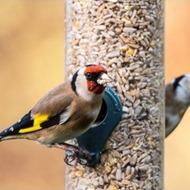 Back
Back Bird Feeders
Bird Feeders  Seed Feeders
Seed Feeders Peanut Feeders
Peanut Feeders Peanut Butter Feeders
Peanut Butter Feeders Suet & Fat Feeders
Suet & Fat Feeders Window Feeders
Window Feeders Hanging Feeders
Hanging Feeders Feeding Stations
Feeding Stations Ground Feeders
Ground Feeders Easy Clean Feeders
Easy Clean Feeders Bird Tables
Bird Tables Seed Trays
Seed Trays Bird Baths & Drinkers
Bird Baths & Drinkers Feeder Accessories
Feeder Accessories Feeder Hygiene
Feeder Hygiene Squirrel Proof Bird Feeders
Squirrel Proof Bird Feeders For the Kids
For the Kids Niger Seed Feeders
Niger Seed Feeders Mealworm Feeders
Mealworm Feeders Bird Food Storage
Bird Food Storage Fat Ball Feeders
Fat Ball Feeders Tube Feeders
Tube Feeders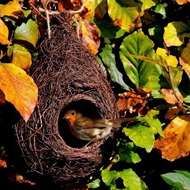



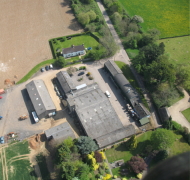 Our Farm
Our Farm Contact Us















